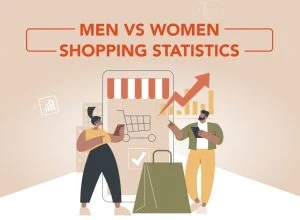Thrifting Statistics 2025: Industry Size, Revenue, and Growth Trends

Thrifting is the practice of shopping for secondhand goods at thrift stores, garage sales, or online marketplaces. This approach allows shoppers to find used items at significantly lower prices than those of new products.
In the United States, thrifting has become increasingly popular, with 93% of Americans shopping online for secondhand goods. On average, thrift shoppers save around $150 each month compared to buying new items. The industry is thriving, boasting over 28,849 thrift stores nationwide, generating $15 billion in annual revenue and employing more than 122,000 people.
As consumer preferences shift toward sustainability and affordability, the global secondhand apparel market is projected to reach $350 billion by 2028. In this blog, we will explore key thrifting statistics and trends that are shaping the future of secondhand shopping in 2025 and beyond.
Thrifting Statistics 2025 (Editor’s Picks)
- 2 in 5 apparel items purchased in the last 12 months were secondhand.
- Around 16% to 18% of Americans shop at thrift stores.
- Thrift store shoppers typically save around $150 each month on average.
- 30% of Gen Z shoppers prefer to buy secondhand items to purchase higher-end brands.
- 93% of Americans purchase secondhand items online.
- On average, thrift store shoppers save $1,760 each year by buying secondhand items.
- 45% of Gen Z and Millennials prefer buying secondhand apparel online, while 38% choose to shop at brick-and-mortar stores.
- 66% of thrifters say that secondhand shopping is more sustainable than buying new.
Secondhand Apparel Market Value Worldwide
The global market value of secondhand and resale apparel was estimated at $197 billion in 2024. This value is projected to rise rapidly in the coming years, increasing by approximately $100 billion by 2026.
Source: Statista
How Many Thrift Stores are there in the USA
There are about 28,849 used merchandise stores in the US, and together, they make around $15 billion in annual revenue. These stores sell secondhand items like clothing, furniture, and accessories, catering to people looking for affordable and sustainable shopping options.
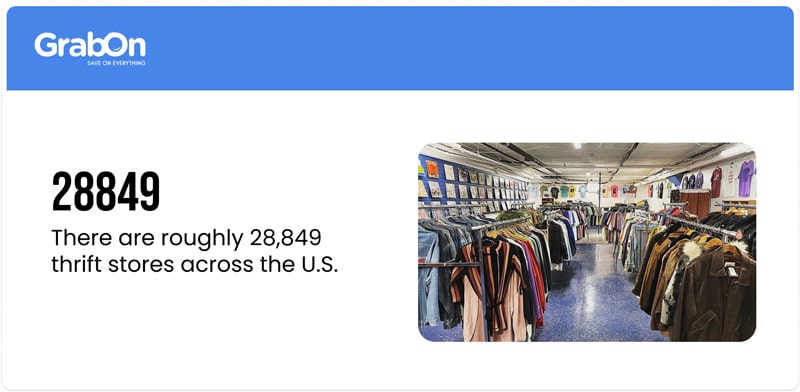
Source: Business Dasher
Secondhand Apparel Market In the USA (In $Billion)
The resale market was valued at $7 billion in 2019. It experienced steady growth, reaching $14 billion in 2021 and $20 billion in 2023. By 2029, it is expected to reach $45 billion, highlighting a major shift in consumer behavior. More people are choosing thrifted and secondhand clothing, driven by a desire for affordability, sustainability, and unique fashion choices.
As a result, the US secondhand apparel market is projected to grow to $74 billion by 2029, reflecting the rising demand for pre-owned fashion and the expansion of online resale platforms.
Meanwhile, the non-resale market grew from $21 billion in 2019 to $29 billion by 2029 but at a much slower pace. A key turning point is expected in 2027 when the resale market surpasses the non-resale market, signaling a stronger shift toward online resale shopping.
| Year | Resale GMV | Non-Resale GMV | Total GMV |
| 2019 | 7 | 21 | 28 |
| 2020 | 9 | 18 | 27 |
| 2021 | 14 | 21 | 35 |
| 2022 | 17 | 22 | 39 |
| 2023 | 20 | 23 | 43 |
| 2024 | 25 | 24 | 49 |
| 2025 | 30 | 26 | 56 |
| 2026 | 34 | 27 | 61 |
| 2027 | 38 | 28 | 66 |
| 2028 | 42 | 28 | 70 |
| 2029 | 45 | 29 | 74 |
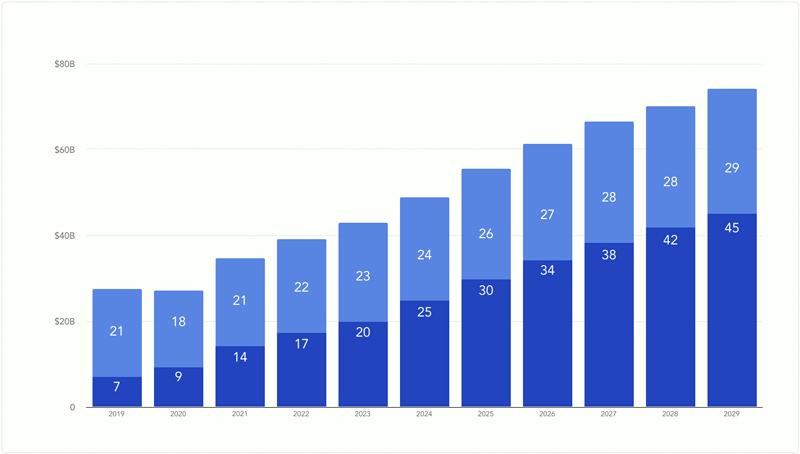
Source: ThreadUp Resale Report
Online vs. Offline Resale Market in the USA
The US online and offline resale market has been growing over the years, but online resale is expanding much faster than offline resale. In 2019 and 2020, online resale was valued at $5 billion, while offline resale remained at $2 billion.
However, from 2021 onwards, online resale started to grow rapidly, reaching $18 billion in 2023 and $22 billion in 2024. By 2029, it is expected to reach $40 billion, growing at a compound annual growth rate (CAGR) of 13%.
On the other hand, offline resale has stayed relatively stable. It was $2 billion from 2019 to 2022, then increased slightly to $3 billion in 2023. It is expected to reach $4 billion by 2026 and remain at that level until 2029.
This shows that more people are choosing to buy secondhand clothes online because it is convenient and offers a wider range of options, while traditional in-store resale remains steady.
| Year | Online Resale | Offline Resale |
| 2019 | $5 Billion | $2 Billion |
| 2020 | $5 Billion | $2 Billion |
| 2021 | $12 Billion | $2 Billion |
| 2022 | $15 Billion | $2 Billion |
| 2023 | $18 Billion | $3 Billion |
| 2024 | $22 Billion | $3 Billion |
| 2025 | $26 Billion | $3 Billion |
| 2026 | $31 Billion | $4 Billion |
| 2027 | $34 Billion | $4 Billion |
| 2028 | $38 Billion | $4 Billion |
| 2029 | $40 Billion | $4 Billion |
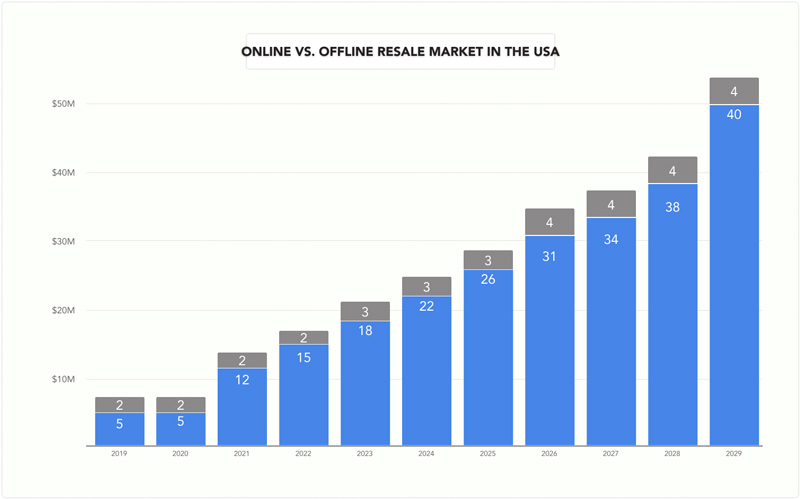
Source: ThreadUp Resale Report
Where Do Consumers Thrift for Clothes?
Among buyers of secondhand apparel, different platforms appeal to different people. About 3 out of 10 buyers prefer peer-to-peer marketplaces, where individuals sell directly to each other. Around 27% choose managed marketplaces, which offer curated secondhand items with quality checks.
18% of shoppers buy through social media platforms, where sellers list items on apps like Instagram, Facebook, and others. Another 11% prefer to buy directly from brands, while 8% shop via livestream shopping. This shows that buyers have different preferences, and online platforms play a major role in secondhand fashion.
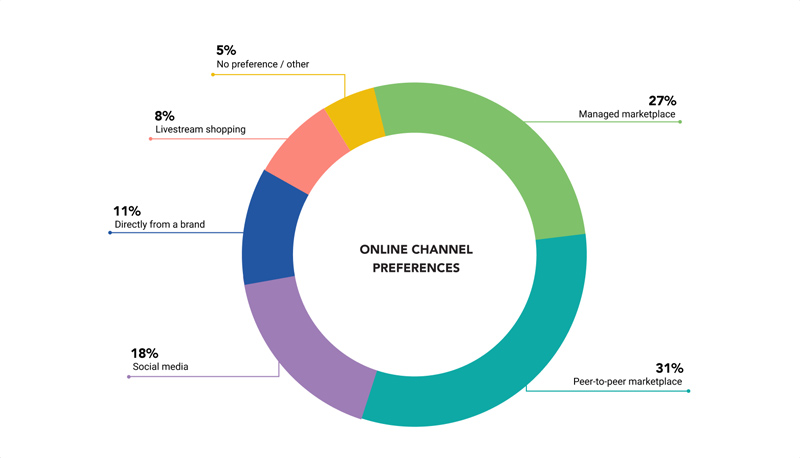
Source: ThreadUp Resale Report
Who Prefers Shopping for Secondhand Clothes?
In the US, millennials make up 33% of secondhand apparel buyers. Meanwhile, 83% of Gen Z shoppers are either already buying secondhand clothes or are open to trying it. This shows that younger generations are leading the shift toward thrifted and resale fashion.
Source: Business Dasher
How Many People Shop at Thrift Stores in the US?
16% to 18% of Americans shop at thrift stores, and on average, these shoppers save nearly $150 every month. This shows that a significant portion of the population is turning to thrift shopping as a way to cut costs while finding unique items. Not only does thrifting help people save money, but it also supports sustainable shopping practices by reducing waste and promoting reuse.
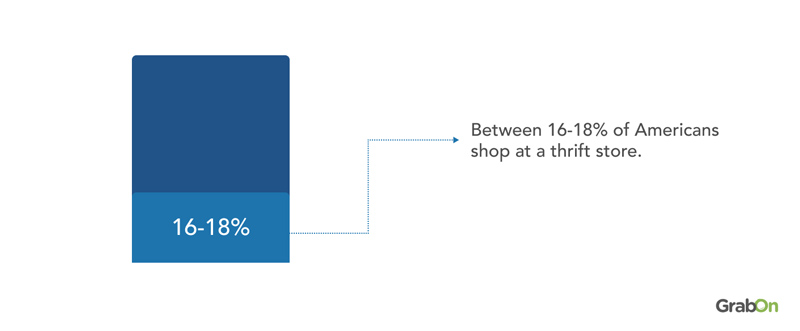
Source: Business Dasher
Over 40% of Gen Zers are Thrifters
About 40% of Gen Z shoppers are into thrifting. Among them, nearly half and 60% of Gen Z thrifters shop for secondhand clothing at least once a month. This shows that Gen Z is not just open to thrifting but is making it a regular shopping habit. To further stretch your savings, Clothing Promo Codes can help you grab brand-new styles for less.
Source: Thrift Industry Report (2024)
Why Consumers Are Spending More on Thrift Shopping
The biggest reasons for spending more on thrifting are that 52% of people enjoy the thrill of finding unique items, and another 52% feel that new clothes have become too expensive. 47% want to get more clothes while sticking to their budget, making secondhand shopping a smart and cost-effective option.
44% enjoy thrifting with friends and family, while 43% do it to help the environment. 40% say they find the styles they like at thrift stores. Money is also a big reason34% have had life changes like job loss or retirement affect their budget, and 32% say household items have become too expensive to buy new.
| % of Consumers | Reasons why consumers are spending more on thrifting |
| 32% | Other household items (Non-clothing) have gotten too expensive to buy new |
| 34% | Life events have changed my budget (Retirement, Job loss) |
| 40% | I can find style I like at thrift store |
| 43% | I want to make a positive impact on the environment |
| 44% | I enjoy thrifting with my friends and family |
| 47% | I want to buy more clothing for the same budget |
| 52% | I enjoy the thrill of thrifting |
| 52% | New clothes have gotten too expensive to buy new |
Source: Thrift Industry Report (2024)
What Americans Thrift Most
The data shows that Americans thrift books the most, with 69% of people picking them up from secondhand stores. Clothes come next at 67%, showing that fashion is a big part of thrifting, followed by furniture at 49%, which many look for to furnish their homes affordably.
On the other hand, records and jewelry are the least thrifted, with only 16% and 18% of people choosing them. Overall, this data highlights how thrift culture blends budget, sustainability, and personal style in everyday choices.
| Items | What Americans Thrift The Most |
| Clothes | 67% |
| Books | 69% |
| Furniture | 49% |
| Decor | 47% |
| Accesorices | 39% |
| Kitchen | 39% |
| Shoes | 36% |
| Toys | 29% |
| Eleconics | 27% |
| Jewelry | 18% |
| Records | 16% |
Source: Thrift Industry Report (2024)
American Thrifters by Age
29.7% of U.S. thrifters fall in the 2534 age group, making them the most active age group when it comes to shopping secondhand. Following closely, 23.8% of thrifters fall in the 35 to 44 age range, showing that many young and middle-aged adults are turning to thrifting as a smart and affordable way to shop.
On the other hand, thrifting is less common among older age groups, of those aged 45 to 54 and of those aged 55 to 64 participating. This shows that thrifting is most popular among younger generations, particularly those in their 20s and 30s.
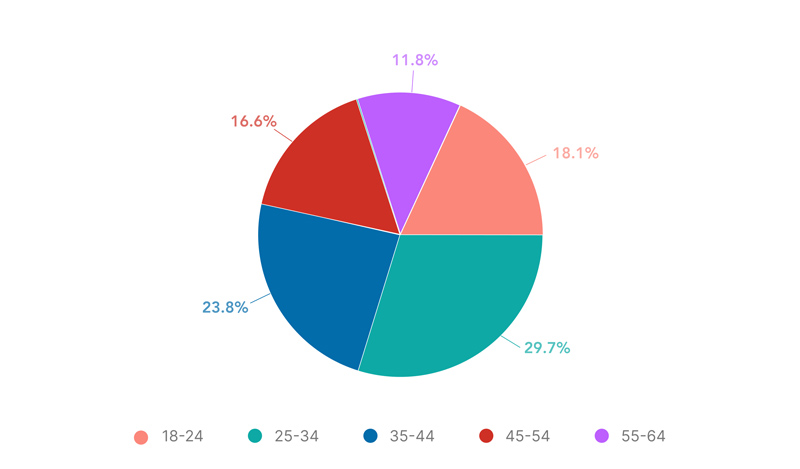
| Age Group | % of Thrifters |
| 18-24 | 18.1% |
| 25-34 | 29.7% |
| 35-44 | 23.8% |
| 45-54 | 16.6% |
| 55-64 | 11.8% |
Source: CapitalOneShopping
Online Thrift Spending Statistics
The data shows a clear upward trend in how much Americans are spending on online thrifting. In 2021, the average sale per buyer was $339.18, which then increased to $457.85 in 2022.
In 2023, it further rose to $554.16, and by 2024, shoppers were spending an average of $665.44. Looking ahead, the average spend is expected to grow even further, reaching $788.38 by the end of 2025.
This consistent increase suggests that online thrifting is becoming more mainstream, driven by factors like affordability, sustainability, and the unique shopping experience it offers.
| Years | Average Spend Per Buyer on Thrifting |
| 2021 | $339.18 |
| 2022 | $457.85 |
| 2023 | $554.16 |
| 2024 | $665.44 |
| 2025 | $788.38 |
Source: CapitalOneShopping
How Long Do People Spend in a Thrift Store?
Overall, most thrifters prefer shopping for 30 minutes to 1 hour, while 29% spend 1 to 2 hours, and 8% shop for more than 2 hours. Only 13% of thrifters spend less than 30 minutes in thrift stores.
- Looking at different age groups, Gen Z shoppers tend to thrift for longer periods, with 35% shopping for 1 to 2 hours and 11% spending more than 2 hours, the highest among all generations.
- Millennials show a similar trend, with 35% spending 1 to 2 hours, 10% shopping for more than 2 hours, and only 9% staying for less than 30 minutes.
- Boomers have the shortest shopping trips overall, with 54% spending 30 minutes to 1 hour, 21% shopping for 1 to 2 hours, and only 3% staying beyond 2 hours.
The data shows that most people spend around 30 minutes to an hour thrifting, but younger generations like Gen Z and Millennials tend to shop for longer, likely because they enjoy browsing for unique fashion pieces and bargains.
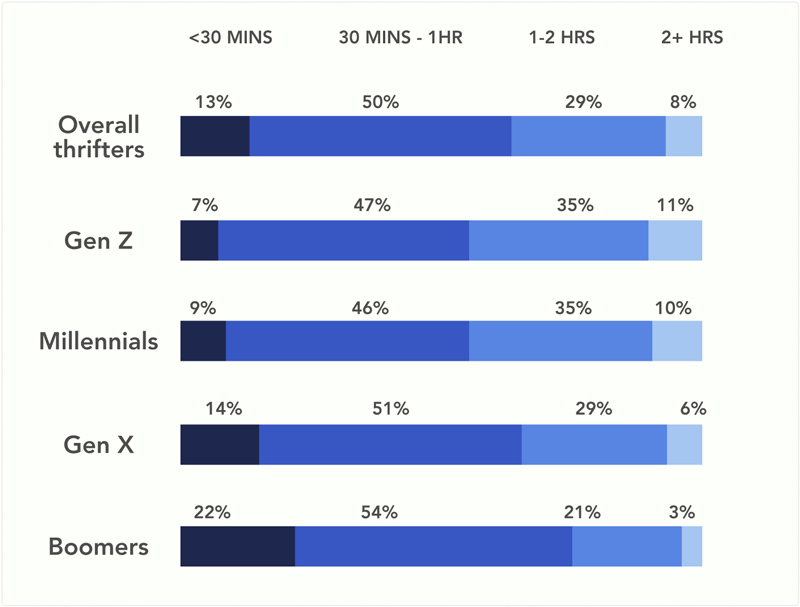
Source: Thrift Industry Report (2024)
Why Americans Thrift
The data shows that most Americans thrift to save money, with 85% saying it’s their main reason. Helping the environment comes next at 42%, followed by finding discounted high-end items at 40%. At the bottom, only 17% thrift to give back to communities, and just 13% do it to resell for profit. Overall, saving money is the biggest driver behind thrifting in the U.S., while reasons like reselling or community support matter to a smaller group.
| Reasons Why Americans Thrift | % of Thrift Shoppers |
| Save money | 85% |
| Help the environment | 42% |
| Find discounted high-end | 40% |
| Find unique clothes or costumes | 33% |
| For fun or thrill | 32% |
| Find affordable furniture | 30% |
| Think it’s cool | 27% |
| To be trendy | 20% |
| Affordable | 17% |
| Give back to communities | 17% |
| Resell items for profit | 13% |
Source: CapitalOneShopping
What Do Thrift Shoppers Look for in an Item?
The uniqueness of the item is the most important factor, with 64% of shoppers valuing it the most. The price of the item follows closely, with 60% considering affordability a major reason for their purchase.
For 36% of shoppers, the brand of the item plays a role, showing that well-known labels still hold appeal in secondhand shopping. 26% of shoppers look for sentimental value, meaning personal memories or emotional connections influence their choices. This data highlights that thrift shoppers prioritize unique, affordable, and sometimes nostalgic items over current trends.
| % of Thrift Shoppers | What Shoppers Look for in Thrift Items |
| 64% | Uniqueness of Items |
| 60% | Price of item |
| 36% | Brand of item |
| 26% | Sentimental Values |
| 14% | Trendiness of item |
| 1% | Other |
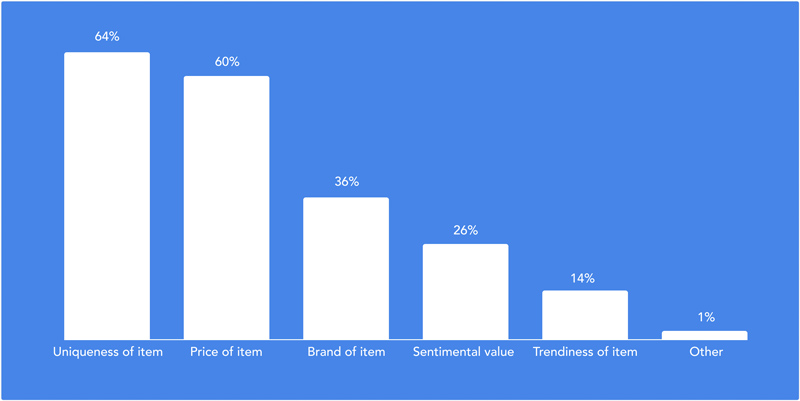
Source: Thrift Industry Report (2024)
Growing Trends in Secondhand Shopping
- In 2024, 32% of people who purchased secondhand clothing bought it directly from a brand.
- 40% of shoppers prefer to try a secondhand item from a brand before committing to buying it new.
- 30% of consumers find online thrifting overwhelming, making it harder to browse and choose items.
- 48% of shoppers say features like personalization, better search tools, and easier item discovery make secondhand shopping feel just as convenient as buying new.
- 59% of shoppers say they would choose secondhand clothing if new government policies make new apparel more expensive.
Why Americans Thrift Gifts
Many Americans prefer thrifting gifts. The most common reason is saving money, with 56% of thrifters saying they choose secondhand gifts because they are more affordable. Sustainability is the second biggest reason, as 54% of shoppers want to reduce waste and make eco-friendly choices.
Additionally, 34% of people appreciate the originality of thrifted gifts. This shows that thrifted gifts are valued not just for their affordability but also for their sustainability and originality.
| % of Thrifters | Reason for Thrifting Gifts |
| Savings | 56% |
| Sustainability | 54% |
| Originality | 34% |
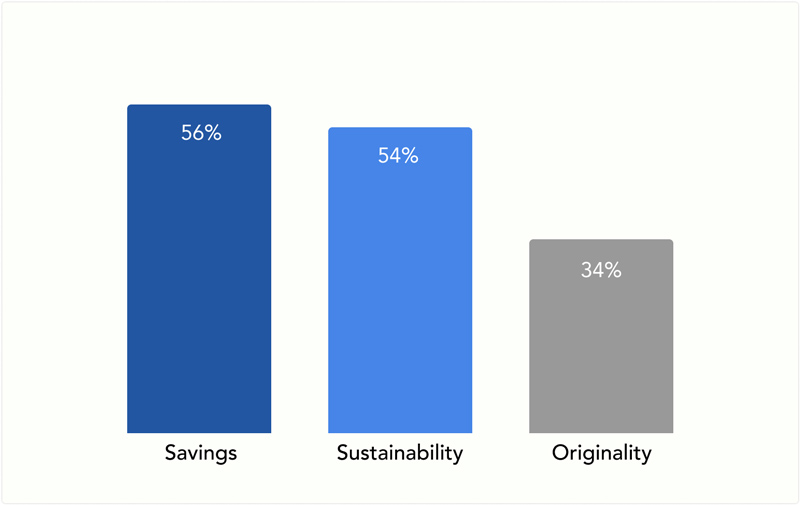
Source: CapitalOneShopping
Wrapping Up
Thrifting has become more than just a way to save money, it's now a growing trend that supports both affordability and sustainability. With 93% of Americans shopping online for secondhand goods and the industry generating $17.5 billion in annual revenue, it's clear that more people are embracing secondhand shopping. Looking ahead, the secondhand market will continue to expand. By 2028, the US secondhand market is expected to reach $73 billion. As more people look to save money and help the environment, thrifting will only grow, offering you a smart and stylish way to shop.
FAQs
Is thrifting sustainable?
Yes, thrifting is a more eco-friendly way to shop. When you buy secondhand items, you’re helping reduce waste and keep clothes and other products out of landfills. With Americans throwing away over 13 million tons of clothing each year, buying used items plays a big role in lowering waste.
What percent of the population are thrifts?
About 16 to 18% of Americans shop at thrift stores every year. That means millions of people are choosing to buy used items instead of new ones, showing that thrifting is becoming more popular across the country.
How profitable is thrifting?
Yes, thrifting is a growing and successful industry. In 2023, the secondhand market in the U.S. made around $53 billion in revenue. More people are buying secondhand, and the resale market is growing fast because of the demand for affordable and sustainable options.
How much money do people save by thrifting?
On average, people who thrift can save around $1,760 every year. Buying second hand instead of new helps you spend less, especially on clothes, furniture, and household items. These small savings can really add up over time.
How many Gen Z consumers thrift?
Thrifting is especially popular with younger shoppers. About 83% of Gen Z consumers have either bought second hand clothes or are open to it. Plus, 34% of Gen Z shoppers say they always check out thrift stores when shopping.
How many thrift stores are there in the US?
There are around 28,849 thrift store businesses across the U.S.


